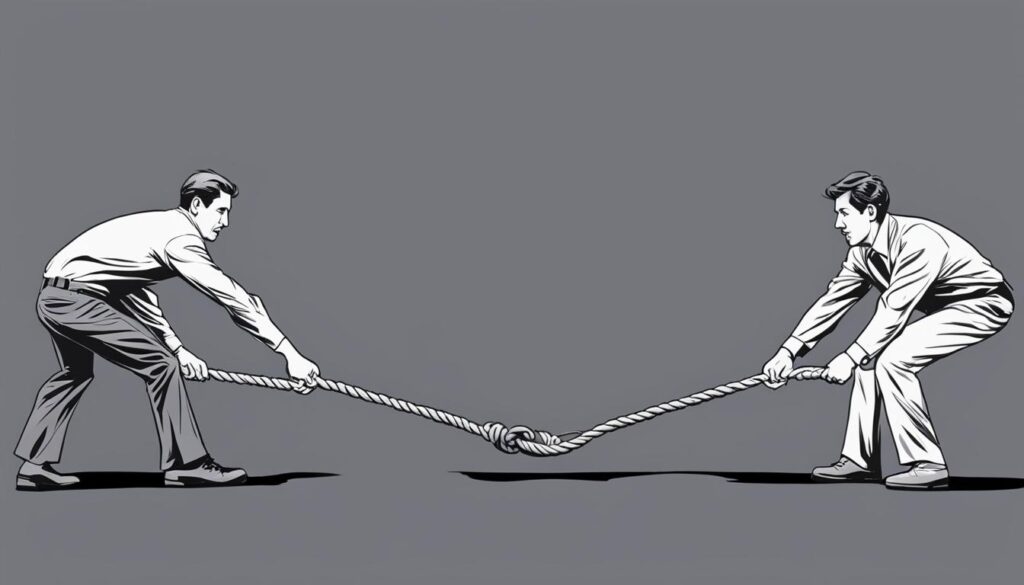Anchoring bias is a cognitive bias that affects negotiation outcomes. It refers to the tendency to give too much weight to the first number or offer in a negotiation and then fail to adequately adjust from that starting point. This bias can significantly impact the final deal price or outcome of a negotiation.
Understanding anchoring bias and learning effective negotiation tactics can help you navigate the negotiation process with confidence. In this article, we will explore the concept of anchoring bias, the power of effective anchoring, strategies for countering the other party’s anchor, the role of power in negotiations, and how to conquer anchoring bias through sound decision-making.
Key Takeaways:
- Anchoring bias can significantly impact negotiation outcomes.
- Making the first offer can give you an advantage in negotiations.
- Be prepared to counter the other party’s anchor effectively.
- Power dynamics play a role in negotiation outcomes.
- To overcome anchoring bias, conduct thorough research and use strategic decision-making.
What is Anchoring Bias in Negotiation?
Anchoring bias is a well-known cognitive bias in negotiation. It occurs when negotiators fixate on the first number or offer presented in a discussion and fail to consider other relevant information. This bias was first documented by economists Amos Tversky and Daniel Kahneman in an experiment involving a roulette wheel. The results showed that even a random number can have a significant impact on people’s judgments. Anchoring bias can affect negotiators’ perceptions of value, making it important to understand and address in negotiations.
According to a study on negotiation simulations, anchoring bias can lead negotiators to focus too heavily on the initial offer and fail to make appropriate adjustments based on new information. This can result in suboptimal outcomes for both parties. Understanding anchoring bias is crucial for negotiators to overcome this cognitive bias and negotiate more effectively.
To illustrate the impact of anchoring bias, consider a negotiation scenario where a seller sets their asking price for a property at $500,000. The buyer, influenced by this initial anchor, may be reluctant to offer a significantly lower price, even if market conditions suggest a lower value. This anchoring bias can prevent negotiators from reaching a mutually beneficial agreement, as both parties may become entrenched in their positions based on the initial anchor.
The Power of Effective Anchoring
Research on the anchoring bias suggests that negotiators who make the first offer are able to gain an advantage in negotiations. Dropping an effective anchor can help shape the discussion in their favor. The decision of whether to make the first offer should be based on factors such as the negotiator’s knowledge of the zone of possible agreement (ZOPA) and their assessment of the other party’s knowledge. Making an aggressive first offer can anchor the discussion and potentially lead to a more favorable outcome for the negotiator.
Understanding the Zone of Possible Agreement
In negotiations, the zone of possible agreement (ZOPA) refers to the range of outcomes that both parties find acceptable. By understanding the ZOPA, negotiators can strategically position their first offer to maximize their chances of achieving a desirable outcome. This requires careful research and analysis of the other party’s needs, preferences, and limitations. Negotiators should aim to make an offer that is both ambitious and realistic, ensuring that it falls within the ZOPA while also pushing the boundaries in their favor.
The Psychological Effect of Anchoring
Anchoring bias works by influencing people’s perceptions and judgments. When a negotiator makes the first offer, it sets a reference point for the discussion. Subsequent offers and counteroffers are then evaluated in relation to this anchor. Research shows that people tend to adjust insufficiently from the initial anchor, often staying close to it when making their offers. This means that by dropping an effective anchor, negotiators can subtly influence the other party’s judgment and increase the likelihood of reaching a favorable agreement.
| Advantages | Disadvantages | |
|---|---|---|
| Advantage | Increased likelihood of achieving a more favorable outcome | Potential risk of alienating the other party if the first offer is too aggressive |
| Disadvantage | Can set a lower anchor if the first offer is too conservative | Potential for the other party to counter with an anchor that is unfavorable |
Overall, the power of effective anchoring lies in its ability to shape the negotiation process and influence outcomes. By strategically dropping an anchor that aligns with the negotiator’s goals and understanding of the ZOPA, negotiators can take control of the negotiation dynamics and increase their chances of reaching a favorable agreement.

Dealing with the Other Party’s Anchor
In negotiations, it is common for the other party to drop the first anchor. When this happens, it is important to recognize the move and defuse the anchor before responding with a counteroffer. By clearly and forcefully stating that the anchor is unacceptable, negotiators can prevent it from influencing the negotiation process. It is also important to quickly move to the counterproposal and provide a clear justification for its fairness. Responding effectively to the other party’s anchor can help maintain a favorable position in the negotiation.
One effective strategy for defusing the other party’s anchor is to use objective criteria and data to support your counteroffer. By presenting facts and evidence that highlight the true value of the negotiation, you can steer the discussion away from the initial anchor and towards a fair and mutually beneficial agreement. It is also important to remain calm and composed during the negotiation process, as reacting emotionally to the other party’s anchor can undermine your position.
Another negotiation strategy for dealing with the other party’s anchor is to make multiple counteroffers. This approach allows you to test the waters and explore different possibilities, increasing the likelihood of finding a middle ground that is acceptable to both parties. By presenting alternative options, you can challenge the other party’s anchor and introduce new perspectives into the negotiation. This strategy requires careful consideration and a thorough understanding of the other party’s interests and priorities.
Tips for Dealing with the Other Party’s Anchor:
- Recognize the anchor: Be aware when the other party drops an anchor and acknowledge its presence.
- Defuse the anchor: Clearly state that the anchor is unacceptable and provide objective reasoning to support your counteroffer.
- Remain composed: Stay calm and composed during the negotiation process to maintain a strong position.
- Make multiple counteroffers: Present alternative options to challenge the other party’s anchor and explore different possibilities.
| Counteroffer Strategy | Advantages | Disadvantages |
|---|---|---|
| Using objective criteria | Strengthens your position with factual evidence | May require extensive research and preparation |
| Making multiple counteroffers | Increases the chance of finding a middle ground | Can be time-consuming and complex |
By employing effective negotiation strategies to counter the other party’s anchor, you can level the playing field and achieve a more favorable outcome. Remember to stay focused on your priorities and objectives, while also remaining open to compromise and collaboration. Negotiation is a dynamic process, and by adapting your approach to the other party’s anchor, you can navigate towards a successful agreement.
Power and Negotiation
Power dynamics play a significant role in negotiation outcomes. Powerful negotiators exhibit approach-related behaviors and are more proactive throughout the negotiation process. They express positive moods, search for rewards, and are less influenced by fear of potential threats. On the other hand, less powerful individuals tend to experience self-inhibition and are more susceptible to external pressures. Understanding the influence of power can help negotiators leverage their position and achieve better outcomes.
Research has shown that power in negotiation is linked to the behavioral approach system (BAS) and the behavioral inhibition system (BIS). The BAS is responsible for driving approach behavior, promoting motivation, and seeking rewards. Powerful negotiators, with their heightened BAS activation, display assertiveness and a focus on achieving goals. On the other hand, the BIS is responsible for inhibiting behavior and activating the fear response. Less powerful negotiators, with their heightened BIS activation, may be more cautious, risk-averse, and focused on avoiding potential losses.
Power dynamics in negotiation can shape the entire process and outcomes. Understanding how power influences behavior and decision-making can help negotiators navigate complex negotiations and achieve their desired outcomes.
It is important to note that power dynamics can also impact the perception of fairness in a negotiation. When one party holds more power, there can be a perceived imbalance and potential for exploitation. Negotiators should be mindful of this and strive to create mutually beneficial outcomes to maintain trust and build long-term relationships.
| Behavioral Approach System (BAS) | Behavioral Inhibition System (BIS) |
|---|---|
| Driven by rewards and positive outcomes | Driven by fear of potential losses |
| Associated with assertiveness and goal-oriented behavior | Associated with caution and risk aversion |
| Expressed by powerful negotiators | Expressed by less powerful negotiators |
By understanding the role of power in negotiation and recognizing the behavioral approach system and behavioral inhibition system, negotiators can effectively navigate power dynamics and optimize their negotiation strategies.
The Creative Risk-Taking of Powerful Negotiators
Powerful negotiators possess a unique characteristic that sets them apart from the rest: they are willing to take risks and think creatively. When faced with negotiations, these individuals focus on potential payoffs rather than potential dangers. They are not afraid to explore novel ways of thinking about problems and are open to unconventional solutions. This risk-taking behavior can have both positive and negative outcomes in negotiations.
On one hand, the willingness to take risks and think outside of the box can help powerful negotiators create value and expand the size of the pie. By considering unconventional options, they can uncover mutually beneficial agreements that might have been overlooked by others. This approach can lead to innovative solutions that satisfy both parties’ needs more effectively.
However, there is a potential downside to this risk-taking behavior. Powerful negotiators may become overly ambitious and pursue strategies that provoke retaliation from the other party. Their willingness to take risks can be seen as aggressive or unreasonable, which can damage the negotiation process and strain the relationship between the parties involved.

Therefore, it is important for powerful negotiators to strike a balance between risk-taking and maintaining a realistic approach. They should carefully evaluate the potential risks and rewards of their actions and consider the potential consequences. By doing so, they can harness the power of creativity while avoiding unnecessary conflicts or negative outcomes.
Losing Perspective: The Downside of Power
Powerful negotiators have a unique advantage in negotiations, but their strength can also be a detriment when it comes to perspective-taking and empathy. When individuals hold a position of power, they often become less attuned to the needs and desires of the other party. This lack of perspective can lead to misunderstandings and hinder the negotiation process.
Perspective-taking is crucial in negotiations as it allows negotiators to understand the wants, needs, and constraints of the other party. Without empathy, negotiators may make assumptions or underestimate the importance of certain issues, leading to suboptimal outcomes. In order to navigate the downside of power, negotiators must actively work on developing their perspective-taking skills and maintaining empathy throughout the negotiation process.
“Empathy is about standing in someone else’s shoes, feeling with his or her heart, seeing with his or her eyes. Not only is empathy hard to outsource and automate, but it makes the world a better place.” – Daniel H. Pink
By consciously striving to understand the perspective of the other party, negotiators can build rapport and trust, which are essential for reaching mutually beneficial agreements. Perspective-taking involves actively listening, asking probing questions, and making an effort to see the negotiation from the other party’s point of view. This approach not only helps negotiators make better-informed decisions but also fosters a collaborative atmosphere conducive to finding creative and win-win solutions.

Key Points:
- Powerful negotiators often fail to take the perspective of the other party into account.
- Perspective-taking is crucial for understanding the needs and constraints of the other party.
- Developing empathy and actively listening can build rapport and trust in negotiations.
- Perspective-taking fosters a collaborative atmosphere and facilitates creative problem-solving.
Conquering Anchoring Bias
Anchoring bias is a common cognitive bias that can significantly impact decision-making in negotiations. To overcome this bias and make more informed choices, it is important to rely on thorough research and gather as much information as possible. By taking the time to gather knowledge and consult with experts, negotiators can mitigate the influence of impulsive decision-making and reduce the impact of anchoring bias.
Additionally, using heuristics can be helpful in navigating cognitive biases. Heuristics such as recognition, one-good-reason, and tallying can provide a structured approach to decision-making and help negotiators consider all relevant information. However, it is crucial to exercise caution and avoid making judgments too quickly. It is important to consider the context and weigh all available data before reaching a conclusion.
Research plays a vital role in overcoming anchoring bias. By exploring academic studies and empirical evidence, negotiators can gain insights into effective strategies for defeating cognitive biases. Understanding the underlying mechanisms of anchoring bias and studying the decision-making processes of successful negotiators can also provide valuable guidance.
Table: Strategies for Conquering Anchoring Bias
| Strategy | Description |
|---|---|
| Thorough Research | Conduct in-depth research and gather relevant information to make more informed decisions. |
| Heuristics | Utilize heuristics such as recognition, one-good-reason, and tallying to systematically consider all relevant information. |
| Consult Experts | Seek guidance from experts to gain insights and perspectives that can help in decision-making. |
| Understand the Mechanisms | Explore academic studies and empirical evidence to understand the underlying mechanisms of anchoring bias. |
| Learn from Successful Negotiators | Study the decision-making processes of experienced negotiators to gain practical strategies for overcoming anchoring bias. |

“The price is only one aspect of the negotiation; understanding the psychology behind anchoring bias allows negotiators to make more informed decisions and achieve better outcomes.”
Conclusion
Anchoring bias is a common cognitive bias that can significantly impact negotiation outcomes. However, with effective strategies and strong negotiation skills, it is possible to overcome this bias and achieve successful outcomes.
One key strategy is to recognize and defuse anchors, whether they are set by you or the other party. By clearly stating that an anchor is unacceptable and quickly moving to a counterproposal, you can prevent it from influencing the negotiation process.
Leveraging power dynamics is another important approach. Understanding the influence of power and adopting an approach-related behavior can help you shape the negotiation in your favor. It’s crucial to maintain perspective taking and empathy, even when in a powerful position, to ensure mutual understanding and create mutually beneficial outcomes.
Lastly, effective decision-making is essential for overcoming anchoring bias. Thorough research, gathering information, and improving deductive reasoning skills can help mitigate impulsive decision-making and reduce the impact of cognitive biases. By using heuristics and considering all relevant information, you can make more informed and unbiased judgments.
FAQ
What is anchoring bias in negotiation?
Anchoring bias is a cognitive bias that affects negotiation outcomes. It refers to the tendency to give too much weight to the first number or offer in a negotiation and then fail to adequately adjust from that starting point. This bias can significantly impact the final deal price or outcome of a negotiation.
How can I deal with the other party’s anchor in a negotiation?
When the other party drops the first anchor in a negotiation, it is important to recognize the move and defuse the anchor before responding with a counteroffer. By clearly and forcefully stating that the anchor is unacceptable, negotiators can prevent it from influencing the negotiation process. It is also important to quickly move to the counterproposal and provide a clear justification for its fairness.
How does power affect negotiation outcomes?
Power dynamics play a significant role in negotiation outcomes. Powerful negotiators exhibit approach-related behaviors and are more proactive throughout the negotiation process. On the other hand, less powerful individuals tend to experience self-inhibition and are more susceptible to external pressures. Understanding the influence of power can help negotiators leverage their position and achieve better outcomes.
What are the risks of power in negotiation?
Powerful negotiators exhibit risk-taking behavior and are more likely to think creatively when faced with negotiations. This tendency can lead to both positive and negative outcomes. It can help create value and expand the size of the pie, but it can also lead to overly ambitious strategies that provoke retaliation. Understanding the risks and benefits of power in negotiation is crucial for effective decision-making.
How can I overcome anchoring bias in negotiations?
To overcome anchoring bias in negotiations, it is important to conduct thorough research and gather as much information as possible. Taking the time to gather knowledge, consult with experts, and improve deductive reasoning skills can mitigate this bias. Using heuristics, such as recognition, one-good-reason, and tallying, can also help reduce the impact of cognitive biases. However, it’s important to be cautious of making judgments too quickly and to consider all relevant information.
How Can Aligning Your Finances with Your Goals Help You Overcome Anchoring Bias?
Aligning your finances with goals can be a powerful strategy to overcome anchoring bias. By setting clear financial goals, you shift your focus from fixed reference points and preconceived notions. This intentional alignment encourages objective decision-making and helps you resist the biases that can hinder sound financial choices.
Source Links
- https://www.pon.harvard.edu/daily/negotiation-skills-daily/what-is-anchoring-in-negotiation/
- https://www.pon.harvard.edu/daily/negotiation-skills-daily/how-power-affects-negotiators/
- https://www.forbes.com/sites/stephaniesarkis/2019/05/31/anchoring-bias-can-weigh-you-down-and-make-you-settle-for-less/?sh=552e708f396b


Pingback: Letting Go of ‘Mine’: Strategies to Reduce Endowment Bias – Straight Fire Money